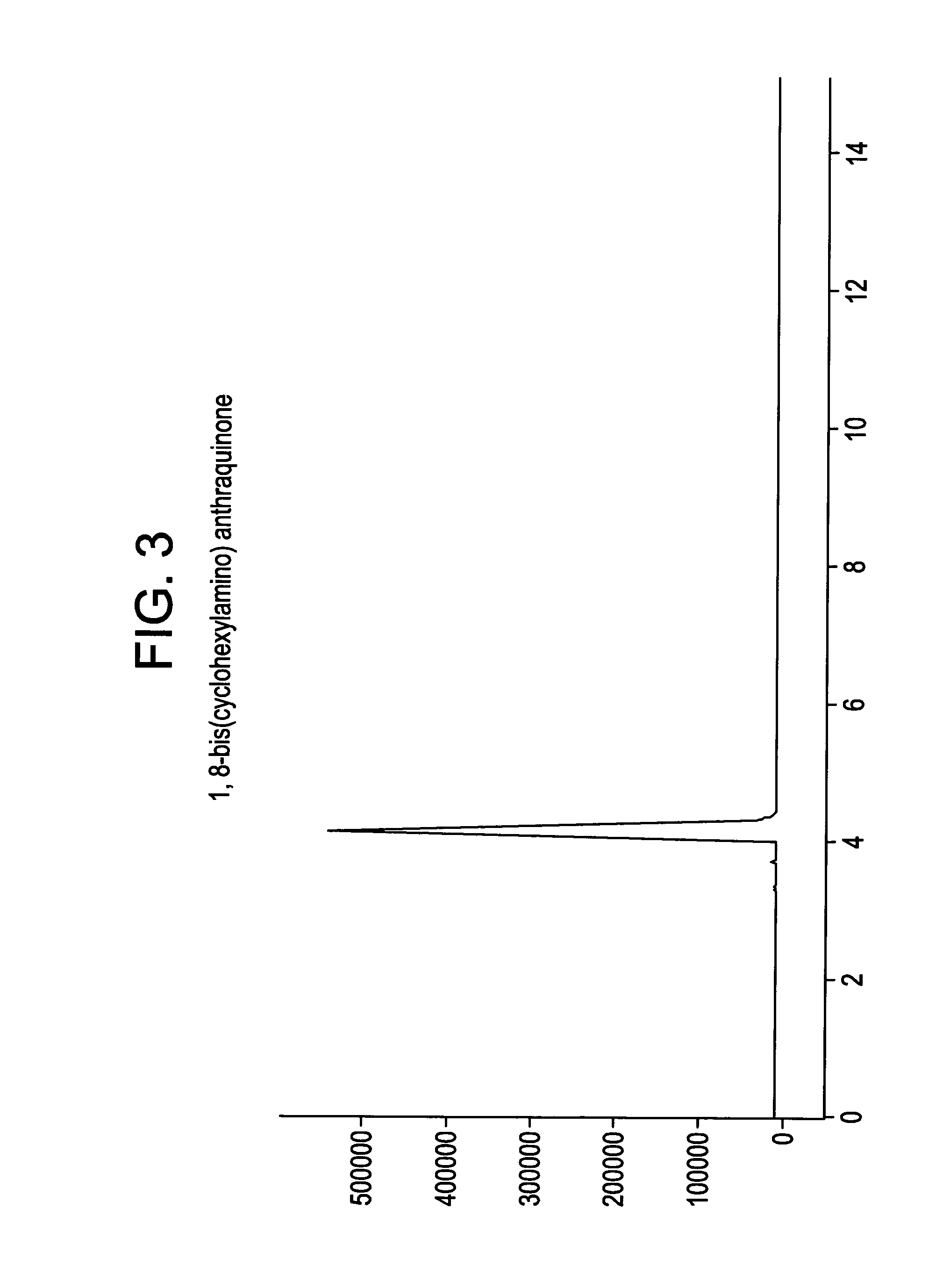Colored polymeric resin composition, article made therefrom, and method for making the same
a polymer resin and composition technology, applied in the field of color polymer resin composition, article made therefrom, and method for making the same, can solve the problems of adversely affecting the ability to cure through the polymer resin, colors, e.g., red-violet portion of the spectrum
- Summary
- Abstract
- Description
- Claims
- Application Information
AI Technical Summary
Benefits of technology
Problems solved by technology
Method used
Image
Examples
example 1
This example details the synthesis of 1,5-bis(isopropylamino) anthraquinone. 3.00 grams (g) (0.011 moles (mol)) 1,5-dichloroanthraquinone, 30 milligrams (mg) copper powder, 30 mg copper(I) iodide and 20 milliliter (ml) (0.235 moles) isopropyl amine were added to 30 ml of ethylene glycol and the resulting suspension was heated to 160° C. in a sealed vessel, which was kept in an oil bath. The heating was continued for 16 hours at 160° C., after which the heating was discontinued and the vessel was allowed to attain room temperature. This was followed by the addition of 20 ml of methanol into the vessel and the contents were stirred for thirty minutes at room temperature. The resulting mixture was then poured slowly into 50 grams (g) of 15% (weight / volume (wt / vol)) ice-cold (i.e., about 5° C.) HCl solution. The precipitate was then filtered, washed free of acid using water and dried under vacuum at 100° C. The yield was 3.00 g. The crude product thus obtained was purified by column-ch...
example 2
This example details the synthesis of 1,5-bis-(−2-N,N-diethylamino-ethylamino) anthraquinone. A mixture containing 5.50 g (0.02 mole) 1,5-dichloro anthraquinone, 60 mg copper powder, and 20 g (0.17 mole) of N,N-diethylethylenediamine was heated to about 120° C. to about 125° C. at atmospheric pressure (about 105 Pascals (Pa)) for a period of 5 hours. The resulting solution was then cooled to 50° C., following which it was triturated with 40 ml of methanol and stirred for an additional hour at 50° C. The product mass thus obtained was then poured slowly into 100 ml of ice-cold water. The precipitated product was then filtered, washed with water and dried overnight at 50° C. The yield was 6.50 g. A 98% purity was obtained as determined using HPLC. The product was characterized by 1H NMR spectroscopy (300 MHz, CDCl3) δ 1.08 (triplet (t), 12H), δ 2.65 (quadruplet (q), 8H), δ 2.82 (m, 4H), δ 3.40 (m, 4H), δ 6.98 (d, 2H), δ 7.54 (m, 4H), δ 9.75 (NH).
example 3
This example details the synthesis of 1,8-bis(cyclohexylamino) anthraquinone. A mixture containing 28.00 g (0.101 mol) 1,8-dichloroanthraquinone, 0.3 g copper powder, and 280 ml (2.45 mol) of cyclohexylamine was heated to 160° C. at atmospheric pressure for period of 15 hours. The resulting solution was then cooled to 60° C., following which it was triturated with 150 ml of methanol and stirred for an additional hour at that temperature. The product mass thus obtained was then poured slowly into 1,000 ml of 15% (wt / vol) ice-cold HCl solution. The product that precipitated was then filtered, washed free of acid using water and dried under vacuum at 100° C. The yield was 37.00 g.
The crude product thus obtained was then suspended in 200 ml methanol and refluxed for an hour, after which the mixture was cooled to room temperature. It was filtered, washed with 20 ml of cold methanol (10° C.), and dried under suction. The performance of TLC (thin layer chromatography) at this stage usin...
PUM
| Property | Measurement | Unit |
|---|---|---|
| thickness | aaaaa | aaaaa |
| hue angle | aaaaa | aaaaa |
| hue angle | aaaaa | aaaaa |
Abstract
Description
Claims
Application Information
 Login to View More
Login to View More - R&D
- Intellectual Property
- Life Sciences
- Materials
- Tech Scout
- Unparalleled Data Quality
- Higher Quality Content
- 60% Fewer Hallucinations
Browse by: Latest US Patents, China's latest patents, Technical Efficacy Thesaurus, Application Domain, Technology Topic, Popular Technical Reports.
© 2025 PatSnap. All rights reserved.Legal|Privacy policy|Modern Slavery Act Transparency Statement|Sitemap|About US| Contact US: help@patsnap.com



